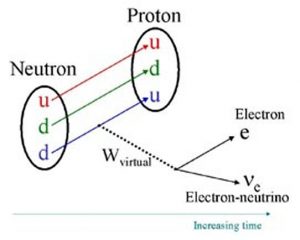Back in High School you probably learned that the atoms that make up everything around us are themselves made up of three types of particles, Protons and Neutron sit at the center of the atom in the nucleus while electrons go spinning around the nucleus. What you might not have learned in High School is that the Protons and Neutrons are made up of particles called quarks and that sometimes Neutrons can ‘decay’ into a Proton, electron and an anti-Neutrino!
Two days ago I attended a physics seminar at my old Alma Matter Drexel University entitled “The Life and Death of the Free Neutron’ given by Doctor Nadia Fomin, Assistant Professor at the University of Tennessee and a researcher at Oak Ridge Laboratory and the National Institute of Standards and Technology (NIST).
For those of you who have never had the pleasure of attending a science seminar let me take a brief moment to give you an idea of what it’s like. A visiting scientist is invited to come and give a talk by a member of the local faculty whose own research is in the same general field. First there is an introduction by the local faculty member mentioning where the visitor is currently working, where they received their degrees and a short description of their research.
Then we get the meat! For the next 45 minutes or so you get to listen to a lecture on the latest research being conducted, the cutting edge of science in action. If the visitor is an experimentalist as Doctor Fomin was you get to hear about the development of their instruments as well as their results but if the visitor is a theoretician you could be treated to 45 minutes of solid math, what could be better than that! After presenting their results the lecturer will then take about 5 minutes to relate what they think their results mean, how they effect what we know about the Universe. Finally there’s about ten minutes given to questions from the audience.
The question period can be the most interesting. I have attended several seminars where a member of the audience was well known to disagreed with everything the visiting speaker was saying and everybody else was just waiting for the clash when the two scientists argued their case. Now there’s no yelling or cursing, everything is calm and deliberate but this is the cutting edge of science in action. Two opposing models of how the Universe behaves, each side has some evidence and a lot of theories as support but neither side has enough to convince the other.
So that’s what attending a scientific seminar is like. Let’s get back to Professor Fomin and her measurements of the decay half life of a free Neutron. Ever since the Neutron was discovered by James Chadwick in 1932 scientists have know that a free Neutron, one that was not confined to the nucleus of an atom, would after some time decay into a Proton and an electron and it was some missing energy in this decay that led Wolfgang Pauli to predict the existence of the Neutrino (although in Neutron decay it’s actually an anti-Neutrino that gets produced). To understand the reaction take a look at the Feynman diagram below.

The Neutron and Proton are both composed of three quarks, two Ups and a Down for the Proton and two Downs and an Up for the Neutron. Now the decay of the Neutron takes place via the ‘Weak Nuclear Interaction’ and it’s half life was first measured after world war 2 to be something around 15 minutes. That doesn’t sound very scientific does it, well Neutrons are very hard to measure, they’re much smaller than an atom, they have to electric charge so it takes a lot effort to learn almost anything about them.
We have made progress since the 1940s, and Doctor Formin and her colleagues are a part of that progress. The best current estimate of the free Neutron half life is between 870 and 880 seconds and the hope is that with new instruments before long that range will be reduced to 0.3 seconds.
Why should we care? What difference does it make whether the Neutron’s half life is 874 or 875 seconds? Well, it does matter because the half life of the Neutron plays an important role in models of the early development of our Universe. Shortly after the Big Bang the universe was a foaming sea of elementary particles that quickly became atoms of hydrogen and helium along with a bit of lithium. Right now the biggest unknown in just how that process took place is the Neutron half life! Also, numerous theories uniting gravity to quantum mechanics, the so called ‘Theories of Everything’ make predictions about the half life of the Neutron and with a better measurement of the half life we can eliminate some of the wrong theories.
Physics began some four hundred years age with Galileo making measurements of falling objects. Measurement is central to what physics is and how it works. I look forward to hearing about Doctor Formin’s results when she gets her new instruments.
